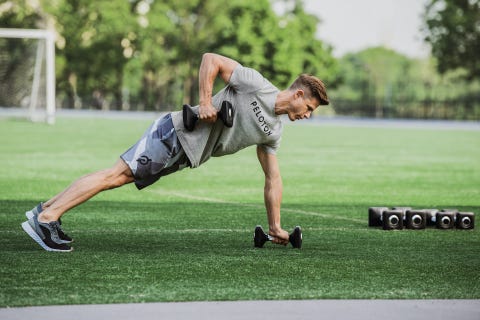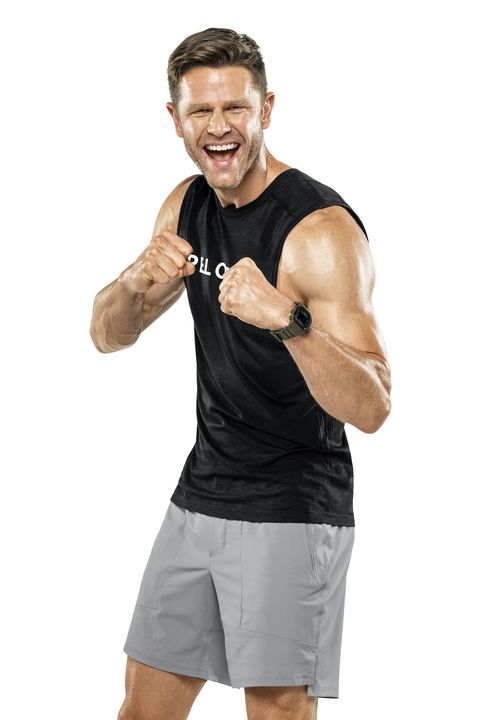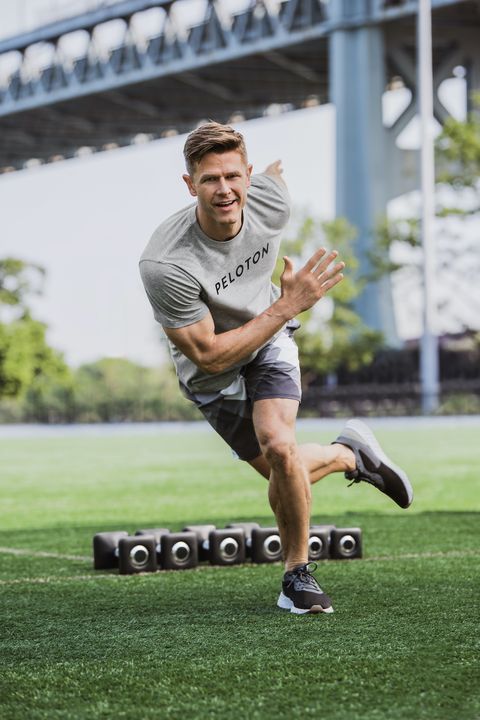Peloton devotees have been loving trainer Andy Speer’s strength classes—and his structured, multi-week programs, like Total Strength 2—for four years, but Men’s Health readers have known about him for even longer: Speer was named MH’s Next Top Trainer in 2014, and appeared in the DVD series The Anarchy Workout in 2015. Along with his MH and Peloton stints, the one-time University of Miami pole vaulter has appeared in programs like MH60 and Shaun T’s T25 and founded Soho Strength Lab in New York City.
“I really got my start with Men’s Health,” the 42-year old says. “So it’s really cool to come back and have a few minutes with the brand.”
Speer took those few minutes to share his 10-minute morning routine for mobility, a travel workout, tips for setting better goals—and reaching them—and a six-minute lower body finisher that will leave you smoked.
This interview has been condensed and edited for clarity.
I’ve read in the past that you start every day with 10 minutes of movement, regardless of what else you’re doing that day. Do you still do that? And what do you do in that 10?
You know, I’m absolutely not perfect with it at all, but it’s one of those things that, you know, when you chunk things up into little smaller bites. Just doing a little bit of something to move around and give yourself a little minute check in with my body. I have like five or six, maybe eight moves—just kind of stretching mobility moves that I’ll kind of run through and just kind of go where my body takes me. And if I need to spend a little more time twisting, I’ll spend a little more time in a twist or maybe a little more time breathing or balancing on one foot or something like that. It’s a really nice way to not overpressure yourself with too much expectation. For me, I’m not necessarily the biggest early morning longer workout or longer training session person. I prefer to do those midday or early evening. But I feel much better when I get up to do a little bit of movement and just have a little mental check-in. Even if it’s not a meditation; maybe I do 5 minutes of mobility and then 5 minutes of a meditation or some breathing or something like that. So I try to give myself 5 to 10 minutes and just do something in the morning. And I feel pretty good about where I’m going after that.
Everything from like, on the back, a single leg windshield wiper, torso twist the other direction. Child’s pose. The classic spider lunge motion. A kind of primal squat where you just kind of move it around, spread the legs out with the elbow up against the abductors. And then on the feet, a couple little balance things. Like I really like starting with a single-leg deadlift toe touch. An airplane is a move which I love, where you’re standing on one leg and you open your hips up and your torso to the wall to one side and then close back down so you’re facing the floor. One or two moves where you just get that little balance, get the vestibular system working for a second.
I’ll just kind of take it where I think I need it that day. If I did a pretty hard work out the day before that maybe I’d sit in a 90-90 for a little bit or do a half kneeling and get the quads and the hip flexors. If I’m feeling pretty good, maybe just trying to move a little bit more in and out of positions, and then get up and maybe even up to the balancing. I might do some jumping—a little pogo either side or diagonal.
It’s not a hard, set, “I have to follow this order every day,” because I’ve tried that. For me personally, some people function differently, if I get myself into “I need to do it every day like this,” and I don’t, I can really get back into like feeling bad about myself and not feeling like I’m doing the right thing. That whole cycle is not great. But if I get myself a little bit of leeway just to spend some time doing something within these options, I generally, at this point, have a better outcome.
What do you think is the missing piece keeping guys from reaching their fitness goals? How can they set better goals?
With goals that aren’t being met, the first thing is just check your goal and make sure it’s reasonable, make sure it’s something that you can attain in whatever amount of time you’re setting yourself up to attain it, and make sure it’s something that means something to you also. if it’s because your buddy wants to bench this much or wants to run this race—sometimes that works, kind of jumping on the coattails to have some accountability. But a goal has to mean something to you. And it doesn’t necessarily have to be an actual goal, but there needs to be that meaning, that purpose that lies behind why you’re pushing yourself in that direction or why you’re pushing yourself to begin with.
Check back in on that and say, is my mile time or beating this AMRAP—is that as a means for me to get more physically fit? Yes. But what is my why? Why do I want to get there? Is my goal to just feel stronger? Maybe, then, it’s to lift 5 pounds heavier over my head with the dumbbell that I have done before. That’s a fantastic goal. Because you have a feeling—you can tap back into that emotion—and then you have something on the analytical side that you can tap into and ask, am I still making progress in getting there?
Another thing is I think a lot of people don’t realize is that the journey to reaching any performance goal, especially in strength, isn’t linear. We set ourselves up for success and most of the programs that I’ll put out, in the past and these days, it’s four weeks, it’s six weeks. It’s a short enough time that you’re kind of going in a pretty linear, uphill approach. But even within that, you’re going to have a day where you didn’t sleep well, where with whatever is going on around you, you maybe don’t feel great, you may be not lifting as much as you did the day before. And that’s okay. With training programs, everything oscillates. Life oscillates. You’re going to go up, you’re going to come down, you’re going to go up and come down. But as long as that overall line is moving to that upward right hand corner, then we’re good. But a lot of people get put off by not realizing that you’re going to have days that you don’t feel great. You’re going to have days where you maybe just need to train easier to let your body have that moment to recover so you can get back up to where you want to be. Whether you call it planned rest or recovery days, whether it’s periodization, having a cycle—they’re different things that have a similar mindset of going in on the hard stuff and then giving your body, giving your training program rest purposely, or if it’s auto-regulation on that day, it’s okay. As long as you’re maintaining that uphill trajectory, you’re good.
Do you have a go-to workout for when you’re on the road or equipment is scarce?
If I’m traveling and if I’m in a place where I can find a hill to run up, I will do that. I don’t always have that option, especially if you’re in a city, but stairs and hills are my favorite go-to for just a short amount of time. Getting in a total body metabolic cardio, you get that speed-strength, you get a bit of plyo effect. It helps with the sprints, it helps with the strength work. I’ll take 15, 20 minutes and just blast out some sprints or even some lunge walks up the hill.
If I have a little bit of time in a smaller amount of space, I will do push up variations and like with the morning, I don’t have a specific 20-20-20 that I do. But I’ll try to run through like five different push variations, maybe get 15 to 20 reps each. I’ll do some type of single-leg balance, some type of single-leg work, like a lunge or a lunge jump. And then I try to throw in handstands whenever I can, especially if I’m traveling. I know everybody doesn’t have the handstand ability, but any way that you can just kind of get inverted, even if it’s a headstand or kicking up against the wall or putting your feet up on the bed and putting your head on the floor or something like that. Even a pike, like an inchworm—walk into an inchworm and just kind of hold that hips-up position and walk back out of it. Getting that blood flow really, really helps kind of offset any sort of static positioning, especially when traveling.
What about within Peloton? Who are your favorite instructors to take a class with?
I’d be remiss if I didn’t say Rebecca! [Ed. note: Speer and Rebecca Kennedy are dating.] I should stop right there. But in all seriousness, I do love her strength classes. We program very kind of similarly, I think.
I love Jess King on the bike because she’s a dear friend of mine, and I love her words and her music. Alex Toussaint—you just cannot be pushing hard with him, which I love. When you need that hard push, Alex is the man.
We’ve got a couple other new guys over in the UK—JJ, Jermaine Johnson, and Ben and Eric—I love their strength classes. I don’t have a bike or tread in my apartment; I’ll listen to the rides and runs as I’m riding my bike around the city. So I generally do more strength work here.
And I also want to say that Ross’ meditations are incredible. We have an amazing yoga and meditation team overall, but I gear towards Ross’ meditations—his visualizations are just tremendous.
What do you do after class for recovery? Do you have a favorite post-workout shake?
A: I have something that I drink after class every day. It’s this stuff called QuickMass. I don’t have any brand affiliation with them. It’s 75 percent carbs, 25 percent protein. I take about a 500-calorie couple scoops of that. And I have a little creatine, five milligrams of just plain creatine monohydrate. For me, just getting in the macros really quickly and efficiently, I also don’t like eating for about about an hour after I do a hard training or a class. I don’t really feel like eating a meal or something. So I just pound that down while I’m getting pulled down from class. And then figure out what I’m going to have when I get home for dinner.
What about a cheat meal? Have a favorite?
I never call anything “cheating.” To preface that, I’m a very lean, skinny person by nature. I’m very carb tolerant. So I eat a lot of carbohydrates. I just have to do to keep up with the energy demands I put my body through. But as far as my favorite go-tos that maybe aren’t the cleanest, I love pizza. I’ll definitely once or twice a week, try to try to nail down a good amount of pizza just to get some calories in. I eat good pizza; it’s not the junk stuff.
And then I think if I’m going to say a “cheat” meal, I’d say cookies. Chocolate chip cookies and a glass of grass-fed whole milk are probably my favorite sweet dessert.
You’re 42 now. What’s changed about your training since turning 40?
I’ve been finding out a lot about my body since I turned 40. There’s definitely some differing focuses and different issues that I’m working on.
I still strength train, one, obviously with my Peloton classes, and I go to the gym and work out with one of my trainers there—Jason, a guy I hired 10 years ago to work there. But I’ve been doing much less top-end strength training as far as grinding out rep maxes on deadlifts and bench and stuff like that. I’m much more concerned with three things: hypertrophy range work just to keep the meat on the bones, if you will.
Second, some lower rep stuff with the bigger lifts, the benches, deadlifts, and squats, but using a lot of chains and bands, using that in working speed and power work. It’s a heavy enough lift and there’s some speed behind it, but it doesn’t get ultra-grindy. That’s been really helpful for my body.
And my third bucket is the connective tissue work, the lower leg, the ankle, the Achilles, the calf. For me, those have always been touchy points. So trying to keep my quickness and my speed up, whether that’s some multi-directional drills on the turf, doing starts, just trying to keep myself feeling athletic rather than feeling like “I can lift this much weight.”
I think every decade we go through these little explorations of where my body’s at, what it needs now, what I want to work on, what I need to stay away from, or what I can push harder. For the thirties and forties, stretching and mobility 100 percent need to stay in, but keeping power and balance drills up I think is really key. And just feeling light on my feet, like I can move in different directions. I get take off in a sprint, whether that’s to teach a class or go play football and run some routes, or just go run around with the dog, that kind of thing.
Any advice you’d give your younger self—or to our younger Men’s Health readers in their 20s?
I started working as a personal trainer in the gym in my late 20s, and I was still pretty active outside the gym running and playing sports. But as time went on, I was spending much more time in the gym, and much less time sprinting, playing outside, playing football, moving freely.
So I would say, if you want to keep up with the gym work, definitely do it. Work on the strength. Don’t overthink it, unless you’re training powerlifting or Olympic lifting, both of which are great. But if you aren’t lifting as a sport, don’t overly concern yourself with the weight as long as you’re feeling strong and don’t lose your athleticism.
And if you’re somebody who didn’t play sports growing up, that’s a great time—after college, or in your 20s or 30s—whether it’s finding a trainer or working on some agility drills, working yourself up to running full speed for a lap around the track, regardless of the time. It’s not about time. It’s about being able to push your body to that 90 to 100 percent effort level without having your ankles blow out or your hip flexors fire up.
So: Keep the play. Keep the sport feeling—light and agile.
Let’s finish with a challenge—or a finisher! Do you have a favorite short challenge workout our guys can try?
Here’s one I’ll do at the end of class. It’s not a full workout, but it’s a great finisher. It’s an isometric squat hold, a bodyweight “tension” squat—meaning a kind of slow bodyweight squat—and then bodyweight squat jumps. You can either do it Tabata-style (20 seconds of work, 10 seconds of rest) and work for six minutes, or you can go 30 seconds each, and work through it three or four rounds.
If you have a light set of dumbbells, like 10 pounds, sometimes I’ll throw a thruster in there as well just to mix it up.
This content is created and maintained by a third party, and imported onto this page to help users provide their email addresses. You may be able to find more information about this and similar content at piano.io





Comments are closed.